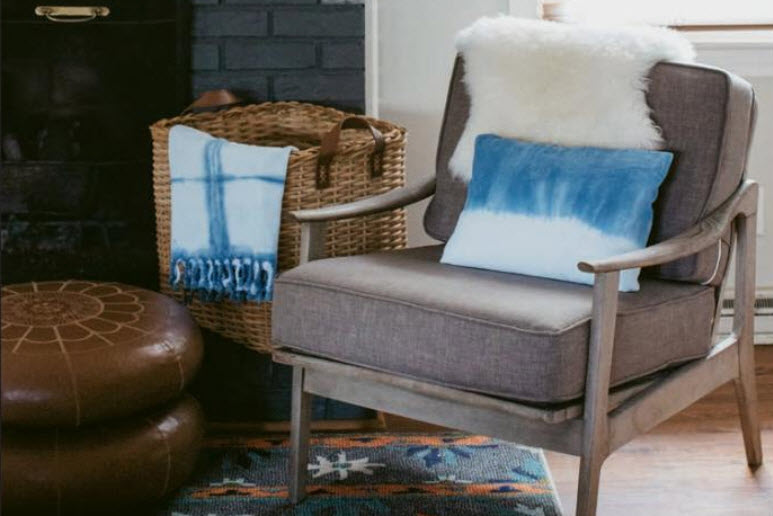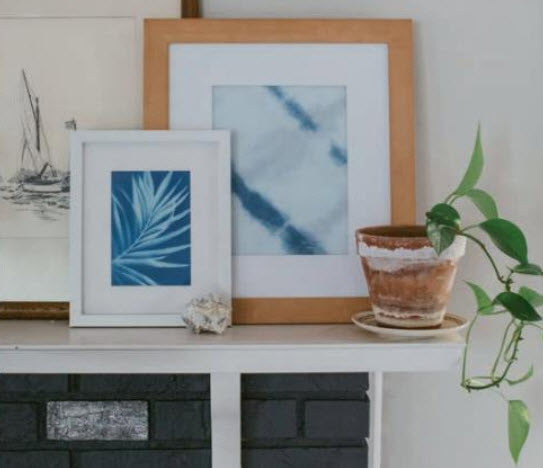What makes the combination of blue and white so appealing in décor? From Blue Willow platters to French Toile to classic Seersucker, the color scheme of blue paired with white continues to anchor spaces in classic and refreshing ways.
But modern tastes or even our tried-and-true classics could use a dose of the organic lines found in the current trend of shibori fabric, also known as dipped-dyed indigo. This isn’t your summer camp tie dye project; the ancient art is less about the kitsch and more about the chic. It’s popping up in high-end design for its graphic two-toned styling which works in a variety of spaces, living rooms to bedrooms, porches to dinner tables.
More...

Pairing a shibori throw with framed cyanotypes (sun-exposed photographs) is a match made in blue and white heaven. The effect is simple and instant, creating a calming, natural element In the home. And, it just so happens to be an easy and satisfying DIY project.
Cyanotype
A photographic printing process producing a cyan-blue print. Employing the same chemicals used in architectural blueprints, you can create blue and white art pieces utilizing found elements, sunshine and water. It’s simple, but with magical results.
-Cold water with a few drops of lemon juice added (this intensi¬fies the blue)
-Paper towels for drying
-Natural objects (flatter items work best)
-A sunny spot but even an over-cast day will work nicely
How To
Think through the layout of a finished piece and then remove a piece of treated paper, avoiding direct sun exposure until the last minute.
Arrange your objects as desired. Place a piece of glass or acetate over top to keep objects in place and to avoid creating shadows. Wait until the blue tinted paper turns almost white and then remove the glass and objects.
Rinse in cold water for a minute and allow your cyanotype to dry on a towel. The blue will darken as the image processes. Frame cyanotypes in simple frames and hang in multiples.
Shibori
The ancient Japanese technique of folding, binding or tying fabric and dyeing it with indigo. Indigo has been used for dyeing cloth in various cultures for centuries. Because it is a natural, plant-based dye, indigo typically needs to be heated to become water-soluble. However, purchasing a kit provides you with prepared dye and fixatives, which can take the guesswork out of your project.

In general terms, you’ll mix four gallons of warm water with the dye along with a reduction agent. Cover the container and wait at least twenty minutes or up to an hour.
-5 gallon plastic bucket with a lid
-Stir stick long enough to stir to the bottom of the container
-A plastic drop cloth to place your fabric on while it oxidizes
-Line to dry larger items
How To
To prep your fabric to dye, you may use accordion folds, which will produce a fluid grid design or you may choose to simply dip dye your piece to form a gradient. Using 100% cotton is your best bet. but silk works beautifully too. Soak the folded cloth in water and then wring it out. After prepping your fabric, remove the foam known as the “flower” from the top of the liquid. You may be surprised to see that the liquid dye is a clear yellow or yellow/green. Don’t worry, that’s exactly what it should look like. The deep blue indigo color appears as the air oxidizes with the dye in the fibers.
Dip your fabric, holding it under the surface for around 10 seconds, making sure the fabric can move freely around the dye vat. It will continue to oxidize as it dries. The blue will intensify and the dye will bleed a bit more into the fabric. Unfolding a dye project to hang on the line is a satisfying surprise. Thanks Beth Brown Ables
